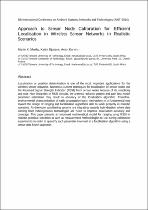 ResearchSpace
ResearchSpace
Approach to sensor node calibration for efficient localisation in wireless sensor networks in realistic scenarios
JavaScript is disabled for your browser. Some features of this site may not work without it.
- ResearchSpace
- →
- Research Publications/Outputs
- →
- Conference Publications
- →
- View Item
| dc.contributor.author |
Mwila, MK

|
|
| dc.contributor.author |
Djouani, K

|
|
| dc.contributor.author |
Kurien, A

|
|
| dc.date.accessioned | 2015-03-12T10:28:40Z | |
| dc.date.available | 2015-03-12T10:28:40Z | |
| dc.date.issued | 2014-06 | |
| dc.identifier.citation | Mwila, M.K, Djouani, K and Kurien, A. 2014. Approach to sensor node calibration for efficient localisation in wireless sensor networks in realistic scenarios. In: The 5th International Conference on Ambient Systems, Networks and Technologies (ANT-2014), the 4th International Conference on Sustainable Energy Information Technology (SEIT-2014), Hasselt, Belgium, 2-5 June 2014 | en_US |
| dc.identifier.isbn | 978-1-63266-900-1 | |
| dc.identifier.uri | http://ac.els-cdn.com/S1877050914006115/1-s2.0-S1877050914006115-main.pdf?_tid=2a26f4ae-b76e-11e4-8b76-00000aab0f27&acdnat=1424264631_3f2c60eaba5e2f18d9814e3c2d538078 | |
| dc.identifier.uri | http://hdl.handle.net/10204/7960 | |
| dc.description | The 5th International Conference on Ambient Systems, Networks and Technologies (ANT-2014), the 4th International Conference on Sustainable Energy Information Technology (SEIT-2014), Hasselt, Belgium, 2-5 June 2014 | en_US |
| dc.description.abstract | Localisation or position determination is one of the most important applications for the wireless sensor networks. Numerous current techniques for localisation of sensor nodes use the Received Signal Strength Indicator (RSSI) from sensor nodes because of its simplicity and cost. Non-linearities in RSSI circuits, the antenna radiation pattern and path loss model parameter estimation may result in accuracy of the localisation algorithm. Therefore, environmental characterisation of radio propagation basic mechanisms is a fundamental step toward the design of ranging and localisation algorithms able to work properly in realistic scenarios. Furthermore, positioning systems are migrating towards hybridisation where data coming from heterogeneous technologies are fused to improve localisation accuracy and coverage. This paper presents an improved mathematical model for ranging using RSSI in realistic practical scenarios as well as measurement methodologies to use during calibration experiments in order to quantify each parameter involved in a localisation algorithm using a sensor data fusion approach. | en_US |
| dc.language.iso | en | en_US |
| dc.publisher | Elsevier | en_US |
| dc.relation.ispartofseries | Workflow;14064 | |
| dc.subject | Antenna radiation pattern | en_US |
| dc.subject | Node localisation | en_US |
| dc.subject | Sensor data fusion | en_US |
| dc.subject | Gauss-Newton optimisation | en_US |
| dc.title | Approach to sensor node calibration for efficient localisation in wireless sensor networks in realistic scenarios | en_US |
| dc.type | Conference Presentation | en_US |
| dc.identifier.apacitation | Mwila, M., Djouani, K., & Kurien, A. (2014). Approach to sensor node calibration for efficient localisation in wireless sensor networks in realistic scenarios. Elsevier. http://hdl.handle.net/10204/7960 | en_ZA |
| dc.identifier.chicagocitation | Mwila, MK, K Djouani, and A Kurien. "Approach to sensor node calibration for efficient localisation in wireless sensor networks in realistic scenarios." (2014): http://hdl.handle.net/10204/7960 | en_ZA |
| dc.identifier.vancouvercitation | Mwila M, Djouani K, Kurien A, Approach to sensor node calibration for efficient localisation in wireless sensor networks in realistic scenarios; Elsevier; 2014. http://hdl.handle.net/10204/7960 . | en_ZA |
| dc.identifier.ris | TY - Conference Presentation AU - Mwila, MK AU - Djouani, K AU - Kurien, A AB - Localisation or position determination is one of the most important applications for the wireless sensor networks. Numerous current techniques for localisation of sensor nodes use the Received Signal Strength Indicator (RSSI) from sensor nodes because of its simplicity and cost. Non-linearities in RSSI circuits, the antenna radiation pattern and path loss model parameter estimation may result in accuracy of the localisation algorithm. Therefore, environmental characterisation of radio propagation basic mechanisms is a fundamental step toward the design of ranging and localisation algorithms able to work properly in realistic scenarios. Furthermore, positioning systems are migrating towards hybridisation where data coming from heterogeneous technologies are fused to improve localisation accuracy and coverage. This paper presents an improved mathematical model for ranging using RSSI in realistic practical scenarios as well as measurement methodologies to use during calibration experiments in order to quantify each parameter involved in a localisation algorithm using a sensor data fusion approach. DA - 2014-06 DB - ResearchSpace DP - CSIR KW - Antenna radiation pattern KW - Node localisation KW - Sensor data fusion KW - Gauss-Newton optimisation LK - https://researchspace.csir.co.za PY - 2014 SM - 978-1-63266-900-1 T1 - Approach to sensor node calibration for efficient localisation in wireless sensor networks in realistic scenarios TI - Approach to sensor node calibration for efficient localisation in wireless sensor networks in realistic scenarios UR - http://hdl.handle.net/10204/7960 ER - | en_ZA |





